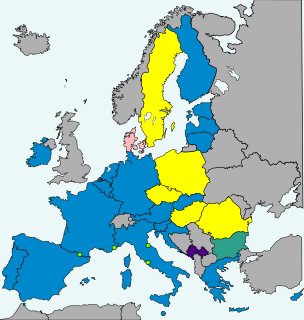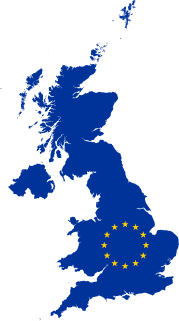
The euro is the official currency of 19 out of the 27 member states of the European Union. This group of states is known as the eurozone or, officially, the euro area, and includes about 349 million citizens as of 2019. The euro is divided into 100 cents.
The European Currency Unit was a unit of account used by the European Economic Community and composed of a basket of member country currencies. The ECU came in to operation on 13 March 1979 and was assigned the ISO 4217 code. The ECU replaced the European Unit of Account (EUA) at parity in 1979, and it was later replaced by the euro (EUR) at parity on 1 January 1999.

The eurozone (EZ), officially called the euro area, is a monetary union of 19 member states of the European Union (EU) that have adopted the euro (€) as their primary currency and sole legal tender. The monetary authority of the eurozone is the Eurosystem. Eight members of the European Union continue to use their own national currencies, although most of them have agreed to adopt the euro in the future.

The European Exchange Rate Mechanism (ERM) II is a system introduced by the European Economic Community on 1 January 1999 alongside the introduction of a single currency, the euro as part of the European Monetary System (EMS), to reduce exchange rate variability and achieve monetary stability in Europe.
The euro convergence criteria are the criteria which European Union member states are required to meet to enter the third stage of the Economic and Monetary Union (EMU) and adopt the euro as their currency. The four main criteria, which actually comprise five criteria as the "fiscal criterion" consists of both a "debt criterion" and a "deficit criterion", are based on Article 140 of the Treaty on the Functioning of the European Union.

Lithuania is an EU member state which joined the Eurozone by adopting the euro on 1 January 2015.

The Czech Republic is bound to adopt the euro in the future and to join the eurozone once it has satisfied the euro convergence criteria by the Treaty of Accession since it joined the European Union (EU) in 2004. The Czech Republic is therefore a candidate for the enlargement of the eurozone and it uses the Czech koruna as its currency, regulated by the Czech National Bank, a member of the European System of Central Banks, and does not participate in European Exchange Rate Mechanism II.

Poland does not use the euro as its currency. However, under the terms of their Treaty of Accession with the European Union, all new Member States "shall participate in the Economic and Monetary Union from the date of accession as a Member State with a derogation", which means that Poland is obliged to eventually replace its currency, the złoty, with the euro.

Bulgaria committed to switching its currency, the lev, to the euro upon its joining the European Union in 2007, as stated in its EU accession treaty. The transition will occur once the country meets all the euro convergence criteria; it currently meets four of the five criteria. Bulgarian euro coins have not yet been designed, but their motif has been chosen to be the Madara Rider. Bulgaria officially joined the ERM II on 10 July 2020. Bulgarian government and central bank officials adopted a draft national plan for euro adoption on 30 June 2021. They stated earlier that day Bulgaria's intention to adopt the euro on 1 January 2024. In May 2022, the government adopted a more definitive version of its plan for the introduction of the euro in Bulgaria that reaffirmed the country's commitment to adopt the euro on the target date.

Romania's national currency is the leu. After Romania joined the European Union (EU) in 2007, the country became required to replace the leu with the euro once it meets all four euro convergence criteria, as stated in article 140 of the Treaty on the Functioning of the European Union. As of 2022, the only currency on the market is the leu and the euro is not yet used in shops. The Romanian leu is not part of the European Exchange Rate Mechanism, although Romanian authorities are working to prepare the changeover to the euro. To achieve the currency changeover, Romania must undergo at least two years of stability within the limits of the convergence criteria. The current Romanian government established a self-imposed criterion to reach a certain level of real convergence as a steering anchor to decide the appropriate target year for ERM II membership and Euro adoption. In March 2018, the National Plan for the Adoption of the Euro scheduled the date for euro adoption in Romania as 2024. Nevertheless, in early 2021, this date was postponed to 2027 or 2028, and once again to 2029 in late 2021.

The 1 euro cent coin (€0.01) has a value of one hundredth of a euro and is composed of copper-covered steel. It is the lowest-value coin in the Eurozone, the next highest are the 2 and 5 euro cent coins. The coins of every Euro country have a common reverse and each has a country-specific (national) obverse. The coin has been used since 2002 and was not redesigned in 2007 as was the case with the higher-value coins.

The 20 euro cent coin (€0.20) has a value of one fifth of a euro and is composed of an alloy called nordic gold in the Spanish flower shape. All coins have a common reverse side and country-specific national sides. The coin has been used since 2002, with the present common side design dating from 2007.

The 50 euro cent coin (€0.50) has a value of half a euro and is composed of an alloy called nordic gold. All coins have a common reverse side and country-specific national sides. The coin has been used since 2002, with the present common-side design dating from 2007.

The 2 euro coin (€2) is the highest-value euro coin and has been used since the introduction of the euro in 2002. The coin is used in 22 countries with a collective population of about 341 million. The coin is made of two alloys: the inner part of nickel brass, the outer part of copper-nickel. All coins have a common reverse side and country-specific national sides. The coin has been used since 2002, with the present common side design dating from 2007.

Sweden does not currently use the euro as its currency and has no plans to replace the existing Swedish krona in the near future. Sweden's Treaty of Accession of 1994 made it subject to the Treaty of Maastricht, which obliges states to join the eurozone once they meet the necessary conditions. Sweden maintains that joining the European Exchange Rate Mechanism II, participation in which for at least two years is a requirement for euro adoption, is voluntary, and has chosen to remain outside pending public approval by a referendum, thereby intentionally avoiding the fulfilment of the adoption requirements.

The euro came into existence on 1 January 1999, although it had been a goal of the European Union (EU) and its predecessors since the 1960s. After tough negotiations, the Maastricht Treaty entered into force in 1993 with the goal of creating an economic and monetary union by 1999 for all EU states except the UK and Denmark.

The United Kingdom did not seek to adopt the euro as its official currency for the duration of its membership of the European Union (EU), and secured an opt-out at the euro's creation via the Maastricht Treaty in 1992, wherein the Bank of England would only be a member of the European System of Central Banks.

The enlargement of the eurozone is an ongoing process within the European Union (EU). All member states of the European Union, except Denmark which negotiated an opt-out from the provisions, are obliged to adopt the euro as their sole currency once they meet the criteria, which include: complying with the debt and deficit criteria outlined by the Stability and Growth Pact, keeping inflation and long-term governmental interest rates below certain reference values, stabilising their currency's exchange rate versus the euro by participating in the European Exchange Rate Mechanism, and ensuring that their national laws comply with the ECB statute, ESCB statute and articles 130+131 of the Treaty on the Functioning of the European Union. The obligation for EU member states to adopt the euro was first outlined by article 109.1j of the Maastricht Treaty of 1992, which became binding on all new member states by the terms of their treaties of accession.
There are nine currencies of the European Union as of 2020 used officially by member states. The euro accounts for the majority of the member states with the remainder operating independent monetary policies. Those European Union states that have adopted it are known as the eurozone and share the European Central Bank (ECB). The ECB and the national central banks of all EU countries, including those who operate an independent currency, are part of the European System of Central Banks.










